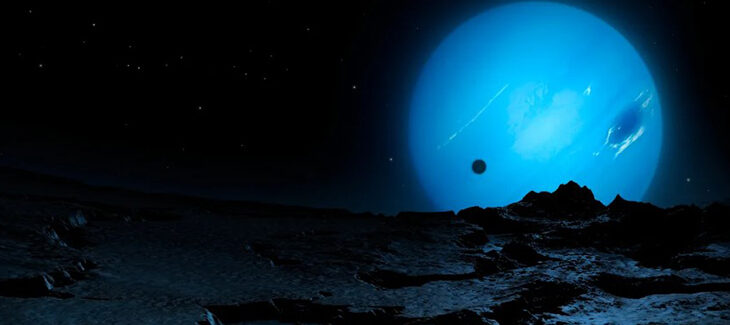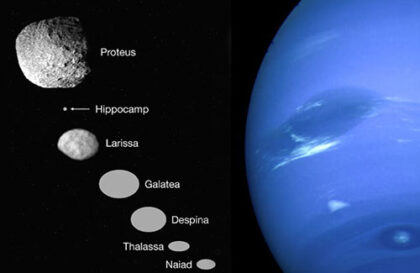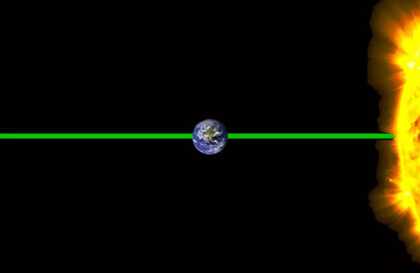Neptune has 14 known moons.
Satellites are divided into two main groups: regular and irregular satellites. Regular moons such as Triton have more stable orbits and are likely to have formed as a result of Neptune’s capture of space objects during Neptune’s early life by accreting material from the solar system’s protoplanetary disk.
Irregular moons, on the other hand, have more unstable orbits and may have been captured by asteroids or comets when Neptune was already formed.
Voyager 2 discoveries
About half of Neptune’s moons were discovered after NASA’s Voyager 2 spacecraft flew past the planet and its system, highlighting just how far telescopic observation has come.
Before NASA’s Voyager 2 probe flew past Neptune in August 1989, only two of Neptune’s moons had been discovered using ground-based telescopes. The first of these, Triton, was discovered by British astronomer William Lassell in 1846, just 17 days after the discovery of the planet Neptune itself. The second moon, Nereid, was discovered by the Dutch astronomer Gerard Kuiper in 1949.
Thalassa probably has a similar composition to Naiad, but despite its small size, the planet is disk-shaped. Both moons also have orbits where they will eventually fall to Neptune.
The spacecraft also found Galatea, which can exert a gravitational pull on Neptune’s rings, and Despina, which is inside the rings themselves.
Discoveries of the Hubble telescope
In 2013, the latest discovery of Neptune’s moon was announced. Scientists have discovered the moon, dubbed Hippocampus, in archival images taken by the Hubble Space Telescope. This satellite, originally designated S/2004 N 1, is extremely small and about 100 million times fainter than what can be seen in the night sky with the naked eye.
The tiny, potato-shaped Naiad is likely a combination of fragments from several of Neptune’s moons, according to NASA. The moon was not discovered by astronomers again until 2013, when scientists used a different technique on Hubble Space Telescope images to reduce Neptune’s glare, making the moon much more visible.
Discoveries of the first moons of Neptune
Astronomers first technically discovered Larissa, a 60-mile (97 km) long moon, in 1981 using a ground-based telescope. However, confirmation of this discovery did not appear until 1989, when the Voyager 2 spacecraft came closer to Neptune. Photographs taken by Voyager 2 showed an asteroid-like body with a surface littered with craters. The orbit of Larissa is slowly approaching Neptune. Scientists suggest that it could eventually collide with the planet’s atmosphere, or break into a ring if tidal forces break the moon apart.
The Proteus satellite was an unexpected find. It turned out to be very large – a diameter of 130 miles (210 kilometers), which is larger than the diameter of the moon Nereid, which astronomers first noticed from Earth. However, Proteus is significantly darker, and this has made it difficult to detect with telescopes. The shape of this moon resembles a lumpy sphere, with numerous craters on its surface. If Proteus were a bit more massive, its gravity would make it more spherical, according to NASA.
Discoveries
In 2002, an important event took place – the discovery of a whole group of satellites was announced, including Laomedea, Halimede, Sao, and Neso. These satellites are so small and located at such great distances that almost nothing is known about them, except for the parameters of their orbits. It is assumed that they could be formed as a result of collisions with small objects scattered near Neptune. The discoveries were made using two powerful telescopes: the 4-meter Blanco Telescope at the Inter-American Observatory on Mount Cerro Tololo in Chile, and a 3.6-meter telescope shared by Canada, France, and Hawaii.
Just a year later, in 2003, the Psamate satellite was discovered using the 8.3-meter reflector of the Subaru Telescope, located at the observatory on Mount Mauna Kea. The orbits of the satellites Neso and Psamate have some similarities.
Credit рhoto:
https://www.nationalgeographic.com
https://esahubble.org



